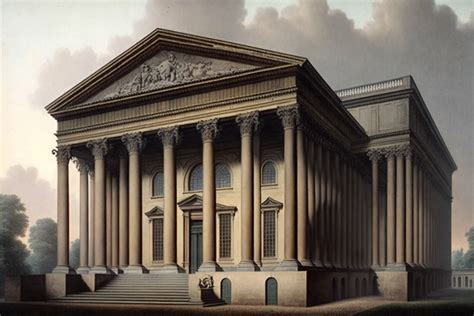Introduction

Classicism reigned supreme as a prominent cultural movement that defined the late 18th and early 19th centuries, spanning the period from approximately 1790 CE to 1840 CE. Rooted in the rediscovery and admiration of ancient Greek and Roman art, architecture, and literature, Classicism emphasized reason, order, and symmetry, leaving an enduring legacy across various artistic disciplines. This article delves into the key characteristics, influential figures, and cultural impact of Classicism during this significant era.
Characteristics of Classicism
Emphasis on Rationality and Order: Classicism subscribed to the Enlightenment ideal of reason as the guiding force in human affairs. It sought to impose a sense of order and clarity in both artistic creation and daily life.
Adherence to Ancient Forms: Artists and architects drew inspiration from ancient Greek and Roman classical models, meticulously studying their principles of proportion, composition, and decoration. They aspired to emulate the timeless elegance and harmony of antiquity.
Simplicity and Symmetry: Classicist works exhibited a preference for simple, geometric forms and a harmonious balance of elements. Symmetry played a crucial role in achieving visual equilibrium and a sense of unity.
Emphasis on Beauty and Perfection: Classicists believed that beauty could be achieved through the pursuit of perfection. They sought to create works that transcended individual idiosyncrasies and aspired to universal aesthetic standards.
Influential Figures of Classicism
Jacques-Louis David (1748-1825): A French painter considered one of the most influential proponents of Neoclassicism. His works, such as “The Death of Socrates,” epitomized the ideals of rationality, stoicism, and heroic virtue.
Antonio Canova (1757-1822): An Italian sculptor who embodied the Neoclassical style in his marble masterpieces. His sculptures, such as “Venus Victrix,” combined classical drapery and idealized forms to create a sense of serene beauty.
Robert Adam (1728-1792): A Scottish architect who introduced the Neoclassical style to British architecture. His designs, such as those for Osterley Park, showcased elegant interiors characterized by columns, pilasters, and refined ornamentation.
Cultural Impact of Classicism
Architecture: Classicism profoundly influenced architectural design, leading to a revival of classical motifs and the construction of monumental public buildings. Structures such as the Brandenburg Gate in Berlin and the Capitol Building in Washington, D.C., continue to bear the imprint of Neoclassical architecture.
Sculpture: Neoclassical sculptors sought to emulate the idealized forms and noble qualities of ancient Greek and Roman statuary. Their works adorned public spaces and private collections, promoting the values of heroism, virtue, and self-sacrifice.
Painting: Classicist painters portrayed historical and mythological subjects with a focus on rationality, order, and moral instruction. Artists such as Jacques-Louis David depicted scenes of civic duty and sacrifice, while others explored romantic and sentimental themes within a classical framework.
Literature: Neoclassicism influenced literature, leading to a preference for form, clarity, and rhetorical elegance. Poets such as Alexander Pope and Samuel Johnson sought to evoke the grandeur and precision of ancient Greek and Roman verse.
Contemporary Relevance of Classicism
Classicism continues to inspire and inform artistic and architectural practices today. Its principles of order, symmetry, and rational design have found application in contemporary architecture, interior design, and even in fields such as product design and typography.
Table 1: Comparison of Classicism and Romanticism
| Feature | Classicism | Romanticism |
|---|---|---|
| Emphasis | Reason, order, and symmetry | Emotion, imagination, and individuality |
| Inspiration | Ancient Greek and Roman art | Medieval and Renaissance art, nature |
| Forms | Simple, geometric | Irregular, organic |
| Themes | Civic virtue, heroism, morality | Love, nature, the supernatural |
Table 2: Key Characteristics of Neoclassicism
| Feature | Description |
|---|---|
| Rationality and Order | Emphasis on clear and logical structures |
| Ancient Forms | Inspired by ancient Greek and Roman art and architecture |
| Simplicity and Symmetry | Preference for simple shapes and balanced compositions |
| Beauty and Perfection | Aspiration to create timeless and universally appealing works |
Table 3: Influential Figures of Neoclassicism
| Figure | Profession | Notable Works |
|---|---|---|
| Jacques-Louis David | Painter | “The Death of Socrates,” “The Oath of the Horatii” |
| Antonio Canova | Sculptor | “Venus Victrix,” “Psyche Revived by Cupid’s Kiss” |
| Robert Adam | Architect | Osterley Park, Kedleston Hall |
Table 4: Cultural Impact of Neoclassicism
| Area of Impact | Influence |
|---|---|
| Architecture | Revival of classical motifs, monumental public buildings |
| Sculpture | Idealized forms, noble qualities, heroic themes |
| Painting | Rationality, order, moral instruction |
| Literature | Clarity, elegance, neoclassical themes |
Conclusion
Classicism, with its emphasis on reason, order, and symmetry, left an enduring mark on the cultural landscape of the late 18th and early 19th centuries. Its principles continue to resonate today, inspiring and informing artistic practices across disciplines. By embracing the harmony, clarity, and timeless elegance of antiquity, Classicism continues to shape our aesthetic sensibilities and guide our creative endeavors.
